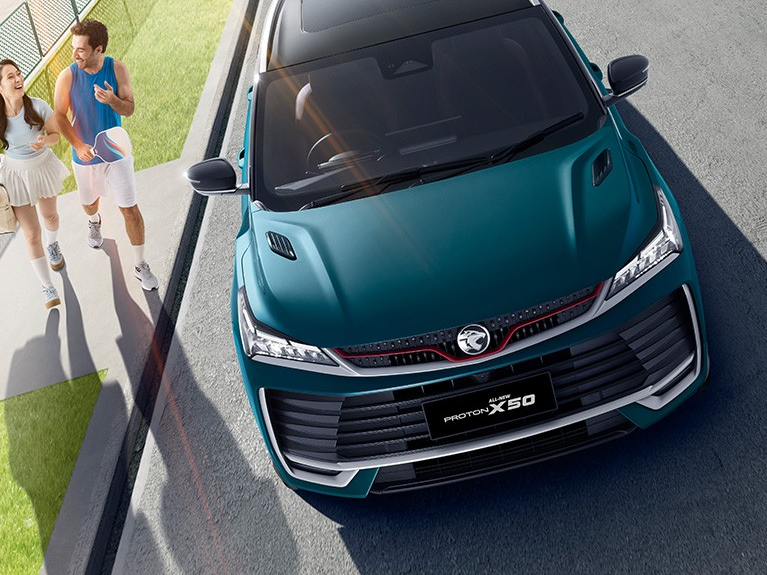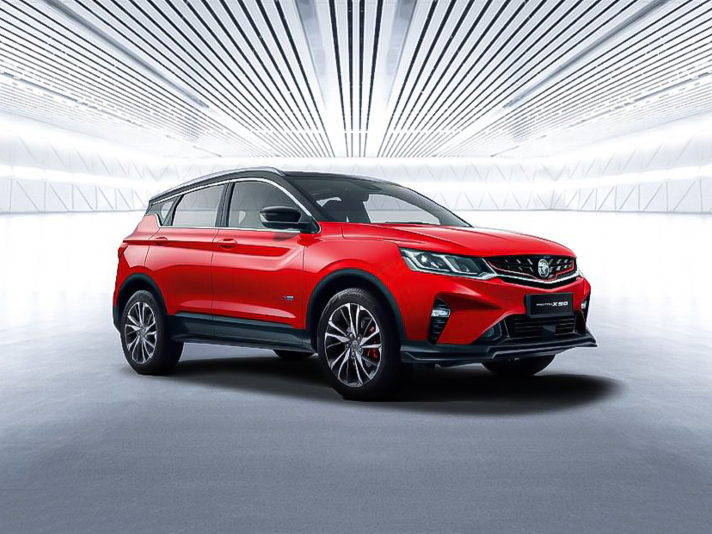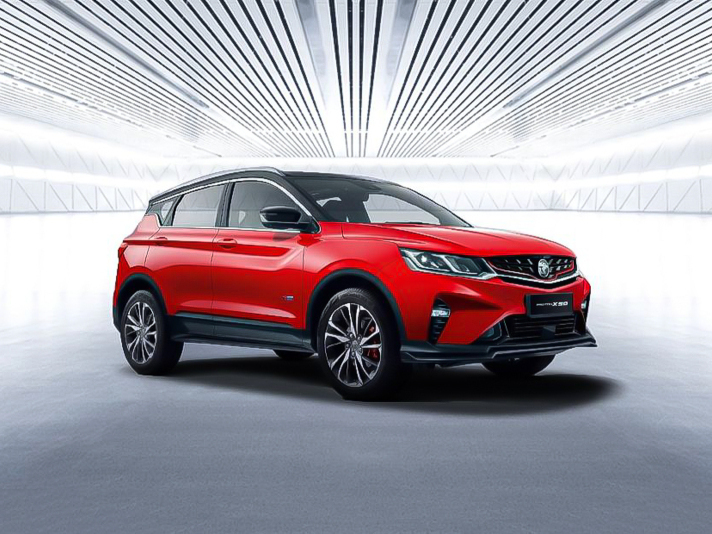Q
What is the rim size of Proton X50?
The rim sizes of different versions of the Proton X50 vary. The Standard and Executive models are equipped with 215/60 R17 tires, paired with 17 - inch aluminum alloy rims. The Premium, Flagship, and the 2025 Proton X50 Sport Edition models, on the other hand, use 215/55 R18 tires, paired with 18 - inch aluminum alloy rims. The numbers and letters in the tire specifications contain important information. "215" represents the tire width in millimeters; "60" and "55" are the tire's aspect ratios; "R" indicates the radial tire structure; and the final "17" and "18" are the rim sizes in inches. Different rim sizes and tire specifications will have a certain impact on the vehicle's appearance, handling, comfort, and fuel economy.
Special Disclaimer: This content is published by users and does not represent the views or position of PCauto.
Related Q&A
Q
What is the fuel consumption of the X50 2025?
Let's talk about the 2025 Proton X50's fuel efficiency. Official figures tell us the 1.5T Standard variant sips around 6.4 liters per 100km in mixed driving, while the 1.5T Flagship nudges up slightly to about 6.7L/100km. Of course, real-world numbers can vary a bit depending on how you drive, the roads you take, and how much you're carrying.
Under the hood, that 1.5-liter turbo engine paired with the 7-speed dual-clutch gearbox does a solid job on fuel economy – it's well-suited for both Malaysian city commutes and highway stretches. If you're keen to squeeze even more km out of each liter, stick to smooth driving habits: avoid jackrabbit starts and sudden stops. Regular maintenance helps too – keeping an eye on tire pressure and swapping out the air filter when needed are simple tweaks that can really boost efficiency.
What's impressive is how this B-segment SUV strikes a nice balance between fuel sipping and performance. It's no wonder the X50 remains a top pick for Malaysian buyers who want something that's easy on the wallet and practical for daily use.
Q
How much is Proton X50 2025 in Malaysia?
The 2025 Proton X50 is currently priced in Malaysia starting from around RM86,300 up to RM113,300. The exact figure depends on the trim level and any optional extras you go for. For instance, the base Standard variant is pretty easy on the wallet, while the range-topping Flagship model comes loaded with more premium features like a panoramic sunroof and advanced driver assistance systems.
As a seriously popular B-segment SUV, the Proton X50 holds a solid spot in the local market thanks to its sharp looks, generous equipment list, and strong value for money. Under the hood, you'll find a 1.5-liter turbocharged engine offered in two states of tune: 150 horsepower and 177 horsepower. It's paired with a 7-speed dual-clutch transmission, striking a decent balance between punchy performance and fuel efficiency.
When you're looking to buy, remember to factor in additional costs like insurance, road tax, and registration fees. It's always a good idea to head down to your nearest official Proton dealer to get the latest pricing and any ongoing promotions. And hey, don't forget to check out rivals like the Perodua Ativa or Honda HR-V too – compare them all to find the best fit for your needs and budget.
Q
What engine is in the Proton X50 2025?
The 2025 Proton X50 gets a brand-new 1.5-liter four-cylinder turbocharged engine. Displacing 1499cc, this powerplant cranks out 181 horsepower and a maximum output of 133 kW at 5500 rpm, while serving up a healthy 290 Nm of peak torque between 2000 and 3500 rpm. Compared to the previous model, this new powertrain should deliver punchier performance and a smoother, more refined driving experience, all while cutting down on engine vibration and noise. Unlike some earlier Proton X50 variants that came with a three-cylinder engine, the 2025 model's four-cylinder setup is likely to better meet consumer expectations when it comes to engine performance and overall refinement.
Q
Does the Proton X50 have Android Auto?
Yes, the Proton X50 does support the Android Auto feature. Users can pair their Android phones with the vehicle's infotainment system via a USB cable, enabling them to use applications like navigation, music, and calls on the car's head - unit, which enhances driving convenience. Besides Android Auto, the Proton X50 is also compatible with Apple CarPlay to meet the needs of iPhone users. Its 7 - inch central control touchscreen offers smooth operation and an intuitive interface design, giving it a strong sense of technology.
It's worth mentioning that the addition of Android Auto and Apple CarPlay makes the X50 more competitive in terms of smart connectivity, especially appealing to the young consumer group in Malaysia. Moreover, the Proton X50 is also equipped with other practical features such as voice control, a rear - view camera, and multiple driving mode options, further enhancing the comfort and safety of daily driving.
If you have any questions about the specific operation or compatibility of the car's infotainment system, it is recommended that you visit an authorized Proton dealer to experience the vehicle's functions in person or refer to the official manual for more detailed usage instructions.
Q
Does the Proton X50 have a sunroof?
Yes, the Proton X50 is indeed equipped with a Panoramic Sunroof, which is a highlight feature of this model. It's especially available in higher - spec versions like the Premium and Flagship. This panoramic sunroof can offer passengers a broader view and better lighting inside the car.
The panoramic sunroof not only enhances the luxury feel of the interior but also adds to the driving pleasure during the night or on sunny days. However, it's important to note that proper maintenance of the sunroof is crucial. Regularly cleaning the tracks and seals can prevent water leakage and abnormal noises.
Given Malaysia's hot climate, it's advisable to use the sunshade when parking the car for an extended period to reduce the temperature rise inside. Meanwhile, the sunroof's UV - protection design can also safeguard passengers from direct sunlight.
As a popular SUV in the local market, the Proton X50 is well - received by consumers for its features and cost - effectiveness. The addition of the sunroof further boosts its appeal. If you're interested in this vehicle, you can visit a nearby Proton showroom to experience its performance firsthand.
Q
Does the Proton X50 have paddle shifters?
Yes, the Proton X50 comes with paddle shifters on certain models, especially the higher - spec versions like the 1.5 TGDi Flagship. This model is equipped with a 7 - speed Dual Clutch Transmission (DCT) and offers the paddle shifter feature, allowing drivers to manually control gear shifts, enhancing driving pleasure and handling flexibility.
The paddle shifters are usually located behind the steering wheel. Drivers can shift gears quickly without taking their hands off the steering wheel, which is especially useful when taking corners or overtaking. It's important to note that the functionality of the paddle shifters may vary depending on the vehicle's configuration. It's recommended to check the specific configuration list of the model before purchasing.
Moreover, while paddle shifters are a great addition to enhance the driving experience, for daily commuting, the automatic mode is usually sufficient. The manual mode is more suitable for those who seek a more engaging driving experience.
As an SUV targeting the young market, the Proton X50 has made many improvements in terms of technology and driving experience. The paddle shifters are just one of them. Other features such as the Advanced Driver Assistance System (ADAS) and intelligent connectivity functions are also worth paying attention to.
Q
Does the Proton X50 have wireless charging?
Yes, some high - end models of the Proton X50 are indeed equipped with a wireless charging function. This feature mainly appears in the Flagship and Flagship X versions, which allows car owners to wirelessly charge their Qi - standard - compatible phones. However, it's important to note that this function may not be applicable to all phone models, especially some older devices or those that don't meet the Qi standard.
As an SUV targeting the young market, the Proton X50 comes with quite a rich set of technological features. Besides wireless charging, it also has an advanced driver - assistance system, a full - LCD instrument panel, and an intelligent infotainment system. These features give it a good competitive edge among vehicles in the same class.
For Malaysian consumers, the addition of the wireless charging function does enhance the convenience of daily driving, especially during urban commutes as it reduces the hassle of dealing with cables. But if you're considering buying the X50, it's advisable to first check if your phone supports wireless charging or visit a showroom to personally experience whether this function meets your needs.
In addition, although wireless charging is convenient, its charging efficiency is usually a bit slower than that of wired charging. So, if you need a quick charge urgently, you may still have to use the traditional USB port.
Q
How much luggage can fit in the Proton X50?
The Proton X50 offers a 330-liter luggage compartment, which is ample for daily use. You can easily fit several small to medium-sized suitcases or shopping bags in it. This makes it highly practical for regular family outings or short trips. If you need more space, the rear seats can be folded down in a 60:40 split. Once folded, the cargo capacity gets a significant boost, making it suitable for transporting longer or larger items like golf bags or small pieces of furniture.
In Malaysia, the Proton X50's compact SUV positioning gives it an edge in city driving and parking, making it more maneuverable. At the same time, it doesn't compromise on practicality. The luggage compartment has a wide opening, making it easy to load and unload items.
It's worth noting that the actual loading capacity can be affected by the shape of the luggage and how it's arranged. We recommend that car owners plan their space usage wisely. If you often need to carry a large amount of stuff, you might want to consider adding a roof box or a luggage rack to increase the cargo capacity.
Overall, the Proton X50 strikes a good balance between daily convenience and occasional heavy-loading needs in its space design, making it a great fit for Malaysia's diverse driving scenarios.
Q
What is the max power of Proton X50?
The maximum power of the Proton X50 depends on the engine version you choose. Among them, the 1.5-liter turbocharged gasoline direct injection (TGDI) engine version can deliver a maximum power of 177 horsepower and a maximum torque of 255 Nm. While the 1.5-liter turbocharged multi-point injection (MPI) engine version offers a maximum power of 150 horsepower and a maximum torque of 226 Nm. Both of these two engine versions are paired with a 7-speed dual-clutch transmission (DCT), providing excellent power performance and fuel economy.
As a popular B-segment SUV among Malaysian consumers, the Proton X50 not only has strong power but also comes with a wealth of technological features, such as the advanced driver assistance system (ADAS) and smart connectivity functions, which meet the modern drivers' needs for safety and convenience. It's worth mentioning that the engine technology of the X50 comes from the cooperation between Geely and Volvo, ensuring its reliability and advancedness. At the same time, Proton has also made targeted adjustments for the local market, making it more suitable for the road conditions and driving habits in Malaysia.
For consumers who value power and technology, the X50 is undoubtedly a choice worthy of consideration. Especially among models in the same class, its cost - performance ratio is particularly outstanding.
Q
How heavy is Proton X50?
The weight of the Proton X50 varies according to different vehicle configurations. The curb weight is approximately between 1,300 and 1,350 kilograms, specifically depending on the selected powertrain version and additional features. For example, models with a 1.5L turbocharged engine are slightly heavier than the entry - level version. The weight design of this vehicle takes into account the rigidity and safety of the body structure while also considering fuel economy. It falls within a reasonable range among compact SUVs.
For Malaysian consumers, the X50 has a moderate weight. It can provide a stable driving experience without significantly increasing fuel consumption, making it highly suitable for urban commuting and family use. Additionally, the vehicle's weight affects its handling and cornering stability. The Proton X50 has achieved a good balance in this regard through chassis tuning and the application of lightweight materials, resulting in a more agile driving feel.
If you're particularly concerned about the vehicle's weight, it's recommended to pay attention to its performance on different road conditions during a test drive to better evaluate whether it meets your personal needs.
Latest Q&A
Q
How much is a Nissan 2018 worth?
The used car prices for 2018 Nissan models in Malaysia vary depending on the model, condition, mileage, and specifications. Generally, the price range is between RM60,000 and RM120,000. For example, the entry-level Nissan Almera might cost between RM60,000 and RM80,000, while higher-spec Nissan X-Trail or Nissan Teana could go up to RM100,000 to RM120,000. Used car prices are also influenced by market demand, maintenance records, and vehicle color. It's advisable to check specific quotes through used car platforms or dealers before purchasing and arrange a professional inspection to ensure the vehicle is in good condition. Additionally, Nissan models are known in Malaysia for their durability and low maintenance costs, especially the Almera and X-Trail, which have a high local ownership rate, ensuring ample parts supply and relatively convenient repairs. If considering financing a used car purchase, it's important to note banks' restrictions on vehicle age and mileage; typically, vehicles over 10 years old or with high mileage will have stricter loan conditions.
Q
How much is a 2018 Nissan Navara?
Prices for the 2018 Nissan Navara in Malaysia's used car market typically range from RM70,000 to RM120,000, depending on condition, mileage, trim level, and location. High-spec VL or V variants usually command a RM20,000 to RM30,000 premium over base E or S models. This pickup truck is known for its 2.5-liter turbo diesel engine (190hp/450Nm) and robust chassis, making it well-suited to local road conditions—especially popular with construction and agricultural users. Its 7.3-meter minimum turning radius and 216mm ground clearance perform exceptionally well across Southeast Asia's varied terrains. Notably, the Navara's used prices sit slightly below the 2018 Toyota Hilux or Mitsubishi Triton, but it offers more affordable maintenance costs. An unexpired original 5-year/150,000km warranty (whichever comes first) can boost resale value. Buyers should verify 4WD system and transmission condition through PUSPAKOM inspection, while checking the ETEMS system to ensure no outstanding road tax or fines.
Q
What is the best selling Nissan in 2023?
The best-selling Nissan model in the Malaysian market for 2023 was the Nissan Almera. This B-segment sedan emerged as a popular pick among local buyers thanks to its budget-friendly price tag, impressive fuel efficiency, and practical features that cater perfectly to young families. Under the hood, the Almera packs a 1.0-liter turbocharged engine, churning out 122 horsepower and 152 Nm of torque, paired with a CVT gearbox. It strikes a nice balance between power and fuel economy, making it especially well-suited for Malaysia's urban driving conditions. The car also comes loaded with Nissan Intelligent Mobility safety tech, including a 360-degree around-view monitor and an intelligent forward collision warning system. It's worth highlighting that Malaysian consumers hold the Nissan brand in high regard, particularly for its reliable durability and extensive after-sales service network, which has helped Nissan maintain steady performance in the local market. Beyond the Almera, the Nissan Navara pickup truck and X-Trail SUV also enjoy considerable popularity, showcasing the brand's competitiveness across different market segments. With the growing trend towards new energy vehicles, Nissan is also gradually introducing its e-POWER hybrid technology in Malaysia, potentially offering consumers more diverse powertrain options in the future.
Q
What is the cheapest Nissan car in 2023?
The cheapest Nissan model in Malaysia for 2023 is the Nissan Almera. This entry-level four-door sedan has become a hit with budget-conscious buyers thanks to its affordable price tag and practical features. Its 1.0-liter turbocharged engine delivers excellent fuel efficiency, making it perfect for city driving, while standard tech like smart keyless entry and a 7-inch touchscreen add to its strong value proposition. When factoring in running costs, the Almera also boasts relatively low maintenance expenses, aligning with Malaysian consumers' demand for economical vehicles. On top of that, Nissan's well-established dealer network and convenient after-sales support in Malaysia provide extra peace of mind for owners. For buyers on a tight budget who still want brand reliability, the Almera is definitely worth considering. That said, rivals in the same segment like the Toyota Vios and Honda City each have their own strengths, so it's advisable for consumers to test drive and compare based on their personal needs before making a final decision.
Q
How much is Nissan Almera turbo 2023 in the Philippines?
The 2023 Nissan Almera Turbo is priced at around 848,000 Philippine pesos (approximately RM70,000, with exchange rates subject to fluctuation) in the Philippine market. This is the entry-level price for the 1.0-liter turbocharged variant, and higher-spec models will cost more accordingly. Under the hood, it packs a 1.0T three-cylinder turbo engine that cranks out 100 horsepower and 152 Nm of torque, paired with a CVT transmission. Fuel efficiency is a key selling point here, with an official rating of 23.3km/L. For Malaysian consumers, the Almera Turbo sits in a similar segment as local B-segment sedans like the Proton Saga and Perodua Bezza, but its turbocharged powerplant gives it a unique edge. It's worth noting that the Philippine-spec Almera Turbo might have slightly different features compared to the Malaysian version (locally known as the Nissan Almera). For instance, the smart key system that comes standard in the Philippines could be an optional extra in Malaysia. Additionally, the automotive tax structure in the Philippines differs from Malaysia, which affects the final selling price. If Malaysian buyers are considering parallel imports, they'll also need to factor in extra costs like import duties and AP permits, which typically make the car significantly more expensive than models from official local channels.
View MoreRelated News

The all-new Proton X50 has sold over 6,000 units in a month and a half since its launch, becoming the champion in its segment.
RobertSep 18, 2025

2025 Proton X50 launched for 5 days and has received 8,000 orders, with 999 units delivered
RobertAug 1, 2025

2025 Proton X50 Facelift Debuts with New 1.5L Four-Cylinder, Priced from RM89,800
AshleyJul 28, 2025

Proton X50 Interior Revealed: A Practical Space Designed for Young Drivers
LienJul 3, 2025

2025 Proton X50 Facelift: Major Upgrades & Possible 4-Cylinder Engine!
RobertJun 13, 2025
View More


















Pros
Cons